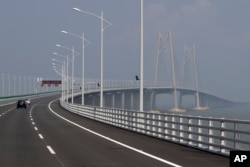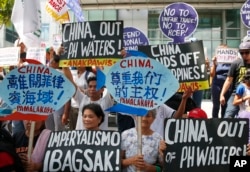Southeast Asian countries are expected to push back gently against Chinese political and economic influence in their region, edging instead toward Western-allied powers, when their leaders gather this month.
Heads of state from the 10-member Association of Southeast Asian Nations, or ASEAN, are due to meet one another as well as leaders and senior officials from China, Japan, Russia and the United States in Singapore at an annual summit November 11-15.
China will use the series of two-way and group meetings to promote new infrastructure projects over the next 15 years in developing Southeast Asia, despite growing international concerns of regional nations becoming indebted to Beijing and resentment of Chinese expansion in a contested sea, analysts predict.
Southeast Asian leaders will engage China at the summit but be more interested in infrastructure projects led by Japan and security offers from Western allies against China’s maritime expansion, they suggest.
“China can block a so-called China-unfriendly agenda but that does not necessarily mean that China can push through a pro-China agenda either,” said Yun Sun, East Asia Program senior associate at the Washington D.C.-based Stimson Center think tank.
Infrastructure projects
Much of Southeast Asia, with a total population some 630 million, has looked to China over the past half-decade for loans and other aid for building railways and seaports. China, the world’s second largest economy, sees these projects as part of its “Belt-and-Road” initiative to open trade routes worldwide.
While Chinese investment has buoyed the sagging economy of Brunei and fired up infrastructure renewal in the Philippines, to name two examples, it worries some countries because of debts owed to China by the likes of Pakistan and Sri Lanka.
In Malaysia, Prime Minister Mahathir Mohamad cancelled two Belt-and-Road projects in August: a $20 billion railway link and gas pipelines worth $2.3 billion, to avoid any further debt.
“I’m not sure whether he’s going to go so far as to try and impose or persuade other countries to follow suit, but I think he definitely wants ASEAN to be more in tune with the rest of the world as opposed to just China,” said Ibrahim Suffian, program director with the Kuala Lumpur-based polling group Merdeka Center.
ASEAN heads will also want to know whether China’s trade disputes with the United States will spill over into their region, analysts believe.
But China may gain favor at the summit over the United States, said Termsak Chalermpalanupap, a fellow with the ISEAS Yusof Ishak Institute in Singapore. China, he said, can also use the event to push for a regional trade pact, something U.S. President Donald Trump opposes as he seeks bilateral deals. Trump will be skipping the event and send Vice President Mike Pence in his place.
“I think China will score and the U.S. will lose because Trump will not come and he will send Pence, who doesn’t know much about ASEAN,” Chalermpalanupap said.
South China Sea dispute
Southeast Asian leaders will pay attention to any offers from Japan to help with infrastructure as well as security in the South China Sea, said Stephen Nagy, senior associate politics and international studies professor at International Christian University in Tokyo.
He expects Japanese summit delegates to talk about development aid, “high quality” infrastructure and “transparent” lending, the latter in “direct contrast” with Belt-and-Road deals.
Japan, backed by the United States, will also find enthusiasm at the summit for its effort to keep the South China Sea “free and open,” Nagy said.
That position goes against China’s, that about 90 percent of the ocean falls under its flag despite competing claims from four Southeast Asian countries. Past Japanese efforts to keep the sea open include naval expeditions and arms sales to Southeast Asian governments.
“There’s nothing being really discussed that’s controversial, for example territorial disputes in South China Sea, which means there’s much more likelihood for a consensus on some of the basic principles that free and open Pacific are based on,” Nagy said.
ASEAN members Brunei, Malaysia, the Philippines and Vietnam claim parts of the South China Sea, overlapping tracts controlled by more militarily powerful China. The 3.5 million-square-kilometer sea is prized for fisheries, fuel reserves and commercial shipping lanes. Over the past 10 years China has landfilled parts of the sea for military infrastructure.
China and ASEAN agreed last year to negotiate a code of conduct for avoiding mishaps at sea, but ASEAN now feels “frustrated” with the progress since then, Sun said.








